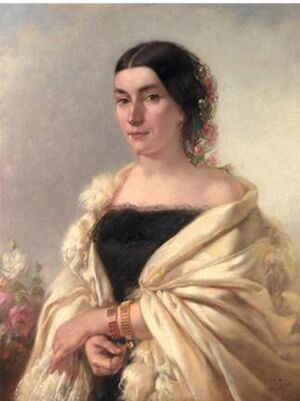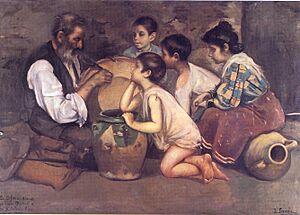Lorenzo Pericás facts for kids
Lorenzo Pericás Ferrer (1868–1912) was a talented Spanish painter. He was best known for his paintings of everyday life scenes, called costumbrista art, and for his detailed portraits of people. His art often showed the culture and traditions of his time.
Contents
Early Life and Art Training
Lorenzo Pericás Ferrer was born in Alcoy, Spain, in 1868. His family was not wealthy; his father worked as a tinsmith. From a young age, Lorenzo showed a strong interest in art.
He began his art studies with a famous teacher named Lorenzo Casanova. Casanova had his own art school in Alicante, called the "Academia de Casanova." In 1885, Casanova saw Lorenzo's talent and took him under his special care. This was a big help for the young artist.
Five years later, Lorenzo received a special grant from the local government, the Diputación de Alicante. This grant helped him continue his art education and focus on his painting.
Growing as an Artist
In 1894, Lorenzo Pericás took part in a big art show called the "Magna Exposición Provincia." This event was organized by a local group and featured artists from all over Spain. Lorenzo and other students from Casanova's academy did very well. They won many medals for their artwork.
Their success was even featured in a well-known magazine called La Ilustración Española y Americana. This helped Lorenzo become more recognized as an artist.
Important Works
After the exhibition, Lorenzo Pericás created several important artworks. He painted "Rehearsing for a Mass" for the sacristy of the Church of Santa María. A sacristy is a room in a church where priests prepare for services.
He also painted for other important places, like the Provincial Savings Bank and a Choral Society. These paintings are now owned by private collectors. Lorenzo also created large wall paintings, known as frescoes, for the "Salón Imperio" at the casino. He even designed beautiful woven pictures, called tapestries, for a palace in Novelda.
Later Life and Legacy
In 1900, Lorenzo Pericás's teacher and mentor, Lorenzo Casanova, passed away. After his teacher's death, Lorenzo Pericás took over as the head of the Casanova Academy. He continued to teach and inspire new artists.
Sadly, Lorenzo had health problems throughout his life, starting from childhood. As he got older, he developed a condition that made it hard for him to move. Eventually, his hands became too stiff, and he could no longer paint.
His friend, Gabriel Miró, who was also Casanova's nephew, organized a fundraising campaign to help Lorenzo. Thanks to this support, Lorenzo was able to live comfortably despite his illness.
Lorenzo Pericás Ferrer died in Alicante in 1912, at the age of forty-four. Even after his death, his art was honored. He received a special tribute at the National Exhibition of Fine Arts in 1912, celebrating his contributions to Spanish art.
See also
 In Spanish: Lorenzo Pericás Ferrer para niños
In Spanish: Lorenzo Pericás Ferrer para niños



